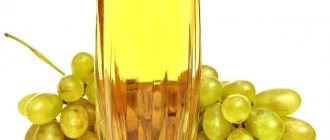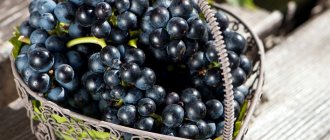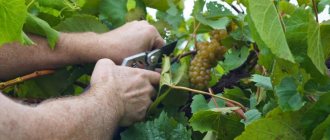Fruits and berries » Grapes
1
697
Article rating
Kira Stoletova
Wine production begins from the moment the harvested crop arrives for processing. Previously, only manual labor was used to crush grapes (more precisely, foot labor: in special vats, wine berries were crushed with feet). The first grape crusher appeared in Spain at the beginning of the 17th century.
Making your own grape crusher
Nowadays, wineries use high-performance installations that can process tens of tons of delivered raw materials in an hour.
You can have a small device in your household. But the production of small-sized cars was discontinued in the mid-80s of the last century. Therefore, winegrowers are forced to create them with their own hands or turn to familiar specialists for help.
Working principle of a grape crusher
Provides 3 technological operations at once:
- separation of juice from the cake through crushing the berries;
- thorough cleaning of twigs and seeds;
- if necessary, separating other parts of the plant.
Such a unit will be useful in a personal plot for making wine from grapes at home. Regardless of the type, the unit consists of the following components:
- receiving hopper (the product is loaded into it);
- movable rollers of various shapes or a rotor (carry out the process of squeezing juice and producing grounds);
- container for collecting pulp and seeds. Read this article on how to grow grapes from seed.
The berries are crushed by rollers, the juice and cake end up in a container for the finished raw materials.
The mechanical type requires the greatest effort. It is rational for two people to process the product: one loads the berries into the hopper, the other turns the handle of the crushing mechanism. The option with a motor allows you to simply pour the product into the container, and then pick up the pulp. Thorough cleaning improves the quality of the base.
A separate category includes destemming presses: roller or impact-centrifugal. They produce additional peeling from grape combs. These parts of the bunch are also needed because they add a hint of brightness and astringency to the finished wine. For the production of red wine varieties, such as Moldavian and Monarch, the use of pulp with ridges is allowed. Read about the Moldavian wine grape variety here. When making white wines, such impurities are not allowed; you will need a type with a separator for enhanced purification.
Read about Monarch wine grapes in this material.
Purpose and principle of operation of the crusher
Almost all crushers for crushing berries have a very simple, but at the same time effective design. The units consist of a receiving hopper for loading, a pair of parallel crushing rollers and a container for collecting pulp.
The volume of grapes required for processing is loaded into a special receiving container. Then, mechanically or electrically, the crushing rollers are brought into operation, crushing the grapes and transporting them to the pulp collection.
The main features of such a unit are the presence of a gap between the teeth of the crushing rollers, as well as their rotation in different directions. The gap allows you to leave the grape seeds intact, which is very important for obtaining quality wine. Damaged seeds give the finished drink excessive bitterness, which is due to too much tannin in them.
Types of grape presses
For large quantities of raw materials, the most popular models are made from the following materials:
- stainless steel;
- plastic;
- varnished wood.
The DV-3 mechanical crusher is designed to obtain juice and pulp from grapes.
All components of the device that come into contact with the product must not oxidize. The most popular are mechanical (manual) and electrical devices made of stainless steel. Their components are convenient to disassemble and wash. They are durable and do not allow the appearance of foreign odors.
To process more than 500 - 700 kilograms of berries, it is recommended to use only a crusher with a motor.
With and without destemmer for berry processing
For production using winemaking technology and processing of fruity white wines, the raw materials must be cleared of grape stems. They ripen earlier than the berries themselves. Because of this, they contain more tannins, which impart excessive bitterness. There are 2 types of such models:
- roller machines (high-quality spin due to a large number of horizontally located elements);
- impact-centrifugal (the process of separating the ridges is carried out due to rotor impacts).
The destemmer is a horizontal cylinder consisting of a shaft and helical blades . The raw materials first fall on this shaft, then they fall on the pressing elements. Devices without destemming are used when processing red varieties such as Cabernet Sauvignon, Merlot and others. This component gives a special aroma to the finished product. Devices with an additional ridge separator come in two types:
- roller;
- impact centrifugal.
A grinder or mill device without a built-in separator is used for processing red and wine grape varieties . For the Muscat and Isabella grape varieties, only options without this function are used, since this reduces the quality of the raw materials.
Read about wine grape varieties here.
The operating principle of crushers with a destemmer is to use a shaft, through which the ridges are separated from the berries.
Roll crushers
The most widespread, used to obtain high-quality raw materials for wine wort. The basis of the unit is a system of horizontal cylinders or blades with adjustable clearance. Operating principle of the unit:
- consists of rollers, built-in destemmer;
- have only vertical loading type;
- horizontally located rollers rotate in different directions;
- there is an adjustable gap between the cylindrical choppers;
- it is activated by turning the handle (mechanical version) or using a motor.
The rollers in different models have different shapes : corrugated, bladed, smooth. Lobed species may have 4, 6 or 8 lobes. The ridges are separated by a special device and then pushed out. Cylinders with a smooth or grooved surface are more often used.
When in motion, the rollers rotate in different directions. Berries that fall between them are crushed. Their skin bursts and the juice and pulp are released.
Impact centrifugal devices
The centrifugal impact model uses a special rotor as its basis. Grinding and squeezing are carried out using the blows of a rotary mechanism. This technology helps to obtain the maximum amount of coloring substances. Design Features:
- vertical or horizontal loading type;
- electric type only;
- maximum yield of phenolic and coloring components;
- rotor rotation at a speed of 500 rpm.
Sectional diagram of an impact crusher.
At the same time, the ridges are separated and thrown out. The result is maximum wort yield.
Mechanical cars
The manual type of devices refers to the roller type of action . Wooden presses are often used to produce homemade wine. Large farms use stainless steel equipment to produce wort. The dimensions and weight of different models depend on the materials and components used. For example, crushers with de-stemming weigh more. The simplest unit consists of the following components:
- square bin;
- two smooth rollers;
- lower frame made of wood;
- gear system;
- side handle.
The vertical loading method is used. Such a device weighs up to 18 kilograms and is placed on a table.
Electric fruit and wine crusher
Allows you to fully automate the production of wort. Electric crushers include an additional ridge separator. The basis is made up of rotating helical-shaped metal blades or a rotor. They ensure the separation of grapes from the ridges. They are pushed out with a forward movement, leaving only juice and extraction in the hopper for further wine production.
Most Grifo crushers are equipped with ridge separators. Considering the complete automation of the process, it is possible to significantly reduce the time and effort spent on processing.
Performance of different models:
- 1200 – 1500 kilograms per hour;
- up to 2000 kilograms per hour;
- 2000 – 2300 kilograms per hour.
Working principle and application
Let's first figure out what a mechanical crusher for grapes is, and what a destemmer for grapes is.
So, a grape crusher with destemmer is a special device used to separate grapes from the stems. The device has a simple operating mechanism: such a crusher consists of a loading tank, a compartment for accumulating cake and a grinder in the form of two crushing rollers, which are located opposite each other.
Why is it necessary to separate the berries from the ridges, you ask? At the time of harvest, the ridges are still green; if they are not removed, acid and tannins will enter the grape juice, which negatively affects the taste of the wine.
A mechanical or manual crusher is widely used both in home winemaking and in the production of wine on an industrial scale. However, for processing large batches of grapes, it is better to use an electric crusher, the power of which allows you to process a large amount of the harvested crop in a short period of time.
How does this miracle device work? Grapes are poured into the loading container, which are literally crushed by crushing rollers. We draw your attention to a small but very important detail: there should be a small gap between the rollers so that the grape seeds remain intact. If the rollers are so close that the seeds rub together, the wine can be considered spoiled. Tannins, which are present in grape seeds, give the drink bitterness, viscosity and strength.
Advantages of using the device
Advantages of producing pulp with an automatic crusher:
- fast processing of large volumes of grapes;
- rational use of resources;
- the opportunity to obtain high-quality pulp;
- automatic cleaning of cake, juice from twigs, excess ridges;
- simplicity and convenience of the unit, which can be improved if necessary;
The simplest wooden model can be assembled with your own hands. It will become a handy tool for owners of small vineyards.
Devices made of wood and stainless steel are popular. They are not subject to oxidation and corrosion. This ensures long-lasting use as the juice is highly acidic.
The only drawback is the inability to use certain types of units for processing nutmeg varieties.
Advantages and disadvantages of pneumatic wine presses
Pneumatic presses expand the capabilities of separating juice from berries/fruits and are quickly being modernized. Operating principle: expansion of the working chamber and the crushing process occurs under air pressure. This device has its advantages:
- Has great productivity.
- Significantly reduces time spent.
- Facilitates the process, as there is no need for manual labor.
Flaws:
- Electricity consumption and, therefore, the need to pay for it.
- Relatively high cost of factory equipment.
Instructions and drawings on how to do it yourself at home
To crush a small crop (up to 500 kilograms), it is enough to build a wooden crusher with your own hands according to the proposed drawing. Its production consists of the following stages:
- Knock down the bottom frame from the boards. Its parameters depend on the number of rollers and the size of the lower bunker.
- Prepare the rolls. They can be purchased at a ready-made parts store.
- Make a bunker for berries from the boards. It should expand from above for ease of loading raw materials.
- To rotate the rollers, 2 metal gears are needed.
- Install the rollers using metal pins. Secure on the outside with gears.
- Select a container for ready-made pulp and juice. The size of the upper part depends on the frame parameters.
After this, the final assembly begins. A support frame with rollers and an upper hopper are attached to the container with the mixture. A handle is attached to one of the roller axes. With its help, the crusher is set in motion. All parts are coated with colorless wood varnish. It must be non-toxic and safe.
In the future, the finished press can be upgraded by adding an electric drive. Additionally, you will need a belt and transmission shaft, and a suitable engine. From a manual form, this form turns into an electric one, which increases efficiency.
Mechanical roller devices
First, a bunker is created. It has the shape of a truncated pyramid. The material for its manufacture can be wood (preferably oak), plastic, stainless steel. The height of the sides can be from 100 to 500 mm. The parameter of the truncated cone must be equal to the length of the rollers.
Next, a wooden frame is made from timber. A cross section of 50 x 50 mm is suitable. The length of the frame is 700 mm, but the width should be equal to the length of the rollers. The optimal option is 200 mm. The surface of the rollers must be corrugated. The distance between them is set to 2-3 mm. It is advisable to make an adjustable gap, since the berries can be of different sizes. The roller system is mounted in the middle of the frame on rods. A gear system is installed on the outside, which will ensure the movement of the rollers in opposite directions.
The frame is installed on a container for collecting pulp, and a hopper for receiving grapes is attached to it. The distance between the rollers and the hopper is no more than 10 mm. A handle is attached to one of the roller rods. I made the simplest grape crusher with my own hands.
conclusions
A grape crusher is a unit designed for the production of juice and pomace. These are the ingredients for making homemade wine and other products.
Before purchasing a crusher, it is important to consider the following nuances:
- All options are divided into 2 main groups: mechanical and electrical. They have almost the same principle of operation.
- The basis is a container for cake, a frame with grinding elements, and an upper part in the form of a bell. A gap is made between the rollers, often adjustable. With its help, the seeds are not crushed, which increases the quality of the cake.
- The choice of model depends on the type and volume of raw materials. To process a small amount of berries (up to 500 kilograms), the simplest form is sufficient. For production on an industrial scale, an electric version will be needed. You will also have to purchase a grape press or make one yourself.
- There are options with and without the comb separation function.
- Allows you to obtain clean pulp without impurities, saving raw materials, time and effort.
- The simplest variety can be improved if necessary.
The simplest variety can be made with your own hands. A wooden form is the simplest manual option. If desired, it can be improved by adding additional elements.
Video “Homemade grape crusher”
From this video you will learn how to make a grape crusher.
DIY grape crusher, design drawings with one drive roller, with the ability to adjust the gap between the rollers.
This mechanism is designed for chopping bunches of grapes and separating the ridges.
Before starting design, it is necessary to carry out a simple technological calculation.
1. Calculate the productivity of the roller crusher (kg/s) using the formula:
П = ½LDδωρφ
L – roll length (m), 0.215 D – roll diameter (m), 0.1126 δ – gap between rolls (m), 0.006 ω – roll angular speed (rad/s), 6.28 (60 rpm) ρ – density of grapes (kg/m3), 1364 φ – crusher utilization factor, 0.5
P = ½ x 0.215 x 0.1126 x 0.006 x 6.28 x 1364 x 0.5 ≈ 0.3 (kg/s)
2. Eight-blade profile roller.
The diameter of the blade is taken to be the maximum diameter of the berry 18 (mm).
3. Technical parameters of the destemmer:
Turn pitch length (mm), 200 Number of whips per pitch length (pcs), 8 Distance between whips (mm), 25 Number of turns, 3 Rotor speed (rpm), 120
4. We build a kinematic diagram of the crusher taking into account the obtained parameters.
5. Determine the power of the electric motor (kW) using the formula.
N = 0.119LDn(120d + D2)
L – roller length (m), 0.215 D – roller diameter (m), 0.1126 d – berry diameter (m), 0.018 n – roller rotation speed (rpm), 60
Substitute the values into the formula and get:
N=0.119 x 0.215 x 0.1126 x 60 x (120 x 0.018 + 0.215 x 0.215) ≈ 0.38 (kW)
6. Let's start building the product.
The grape roller crusher consists of the following components:
- Frame.
- Bearing housing cover.
- Roll.
- Desalter.
- Sieve.
- Plexiglas.
- Electric motor AIR63V2.
- Ridge unloading bunker.
- Loading hopper.
- Gear.
- Belting.
General drawing.
Welded stainless steel construction. The main requirement is to maintain the alignment of the holes and grooves, their perpendicularity to the drilling and milling plane.
BEARING HOUSING COVER
It consists of a plate to which bearing housings are welded. When installing the cover on the body, the axes of all holes and grooves of the cover must coincide with the axes of the holes and grooves of the body and lie on the same line.
- Roll.
- Rubber compressor.
- Prismatic key 6x6x20.
- Prismatic key 6x6x70.
- External retaining ring 20x1.2.
The design has two rolls, left and right.
The left roller is driven by a gear. The right roller does not have a 6x6x20 prismatic key, which ensures its rotation under the influence of the left roller and the product being ground. COMBET SEPARATOR
Made of thin stainless steel sheet metal, in the form of a half-cylinder with staggered holes with a diameter of 16 (mm) along the entire length.
Plexiglass
Closes the comb separator from above and makes it possible to observe the process of comb separation.
ELECTRIC MOTOR AIR63V2
Since the working speed of the mechanism is small, it is necessary to use a frequency converter together with the selected electric motor.
GEAR
Gear parameters.
Any gardener involved in growing grapes for subsequent wine production is familiar with such a tool as a crusher. There are several variations of the mechanism, and they will be discussed in this article.
The crusher is a device with a simple mechanism. The most primitive design consists of the following elements:
- bunkers for loading berries;
- containers in which the cake is collected;
- crushing rollers;
- frame holding all components;
- handles driving the shafts;
- gear systems.
The tool is used by private winemakers and industrialists to process grapes to obtain juice.
Roller crushers-stemmers for grapes
The operating principle is based on filling the bunker with berries and driving the working shafts,
which, under the force of squeezing, press the skin and pulp, separating the juice. The processed product goes into the pulp collection compartment. The drive that makes the crushing elements move can be mechanical or electrical.
The shafts of the device must move in the opposite direction.
A design feature is the gap that is left specifically between the working shafts. This allows you to squeeze the grapes without crushing the seeds. Damaged seeds negatively affect the taste of the juice, subsequently imparting bitterness to the wine.
How to filter wine at home, how to replace a factory wine filter press?
Sometimes wine needs cleaning. In industrial conditions, this is done using a filter press. At the same time, connoisseurs note that filtration kills the taste, and aesthetes insist that drinking a pure drink is much more pleasant. If you can’t buy a wine press filter, you can replace it:
- Gelatin will perfectly save the situation. Important! It is advisable to purify only light and white wines in this way. For one hundred liters of drink, take 10 grams of gelatin. It is necessary to immerse it in cold water for 24 hours. After the gelatin swells, place it in warm water and dissolve. Then pour it into the wine and leave it for several weeks to clean and separate the sediment.
- Protein will help make red wine clear. You only need to take two proteins per hundred liters of wine. They need to be whipped into foam with a small amount of water. After 20 days, you can notice the result of cleaning and carry out filtration.
- Milk. Low-fat cow's milk is excellent for lightening. A teaspoon is added to 1 liter of wine drink. The process of separating sediment and clarifying the wine will take several days at a temperature of 23 degrees.
- Heating the wine will make it clear as a tear. The drink in a glass container must be closed, placed in another larger container and poured cold water into it. It is necessary to heat slowly to 50 degrees. After cooling, the procedure is repeated three times.
- Exposure to cold. If you cool the wine to -2 degrees, the sediment will sink to the bottom. Then remove the drink from the sediment and filter.
- If fusel oils and odor are present in the wine, then you can resort to activated carbon. Charcoal is crushed to a starchy state. Ten liters of wine with 3 grams of coal need to be steeped for three days. Cleanse once a day.
- Tannin from oak heartwood can be purchased in pharmacies. It will clear cloudy wine. Ten grams of the substance are diluted in two liters of water. One liter of wine requires 6 tablespoons of tannin. It needs to be left for about ten days, then removed from the sediment.











